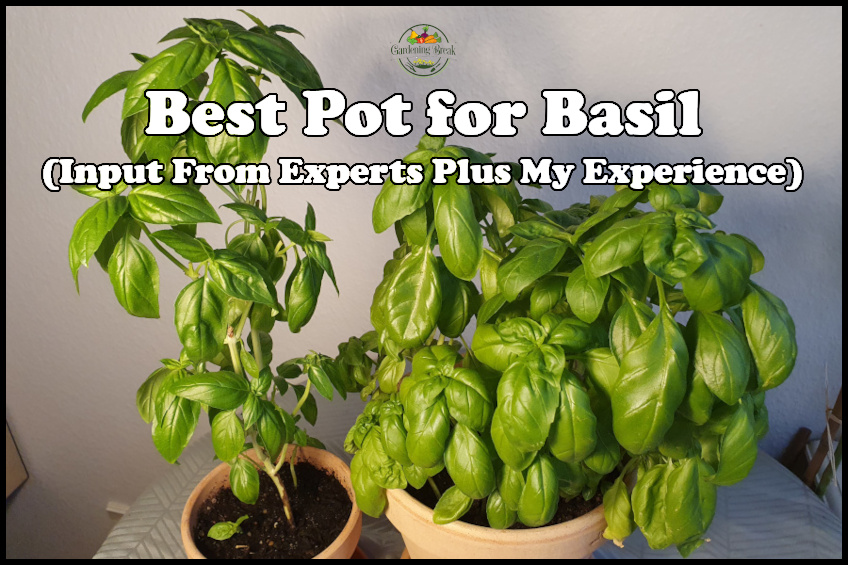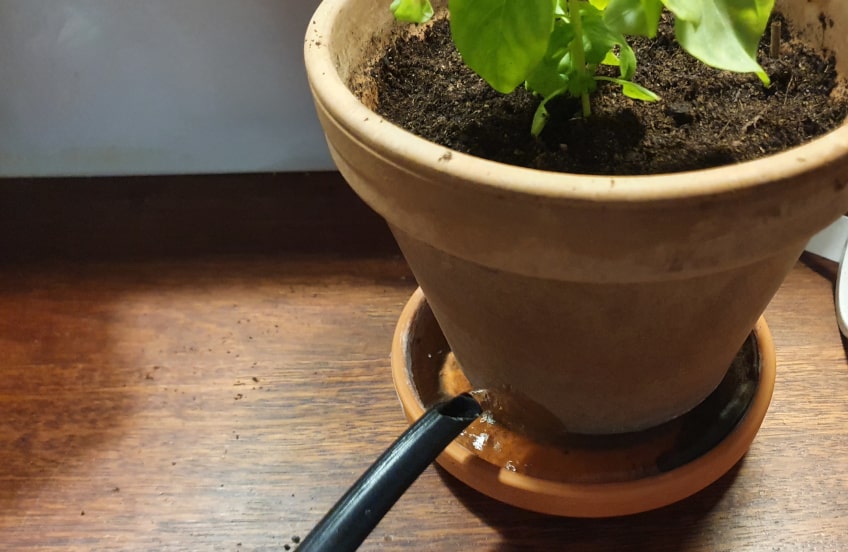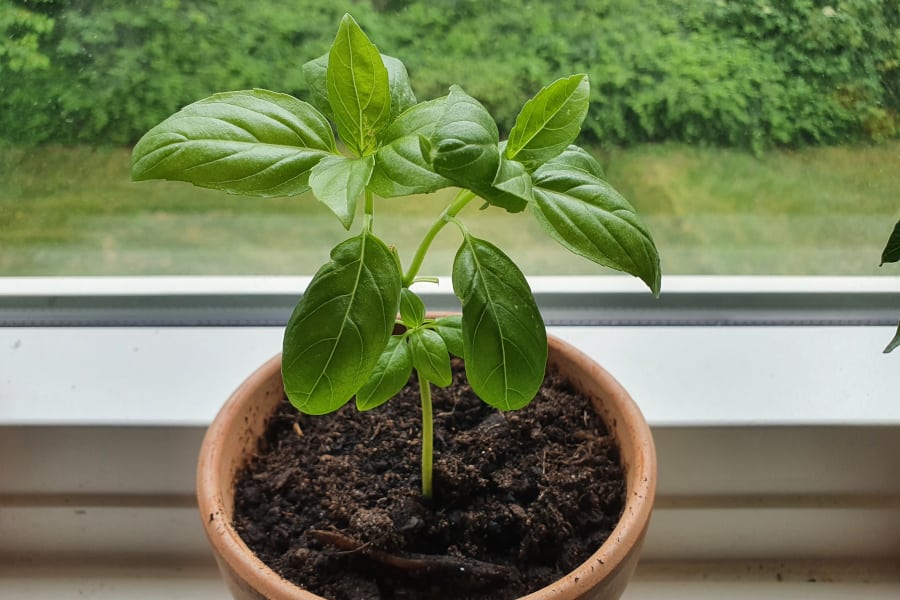Choosing the right pot for your basil might seem trivial but it is actually one of the most important decisions you have to make when growing basil since it has a significant impact on how well it will grow. I teach you everything you should know in this article but here is a very brief conclusion if you’re just looking for a quick answer.
The best pot for basil plants is an 8-12 inches (20-30 cm) wide and deep terra cotta pot with a drainage hole. I go into more detail and explain why this is the case below.
Basil was one of the first plants I started growing many years ago and I have used a wide variety of pots and containers of different sizes and materials for it so I know precisely what works and what doesn’t. On top of that, I have talked to several true gardening experts about which pots work best and why.
I have written this article based on my talks with several professional gardeners, primarily from garden centers and nurseries, and my own experience from growing basil for many years.
In this article, I explain specifically what you should look for in a pot when it comes to size, material, and more. I also recommend some specific pots for your basil and explain why I use them and prefer them over others as well as why the other gardeners I talked to recommend them too.

Best Pot for Growing Basil (Best Size and Material)
Your choice of pot can be what determines if you will be harvesting more basil than you know what to do with or none at all.
In my experience, size and material are two of the most important factors when choosing a pot for growing basil. They both play an important role in how well the plant grows, which I have certainly seen for myself, so let’s begin with those but keep reading as there is a bit more to it.
The best pot size for growing basil is 8-12 (20-30 cm) inches depending on how large you want the plant to get. A pot that is 8 inches (20 cm) wide and deep is usually sufficient, although if you want your basil plants to get as large as possible, go with a pot that is at least 12 inches (30 cm) wide and deep.
The best material for a pot for growing basil is terra cotta or another unglazed type of clay. This is the best material because it provides excellent drainage and allows the soil to “breathe”, as the water can escape through the sides of the pot.
It is also crucial that the pot you choose has a drainage hole to prevent water from staying in the soil for too long as it can damage the roots.
What pots do I use and recommend?
I almost always use unglazed terra cotta pots like the ones you can see in the photos in this article and all over my website. Here are some from Amazon. They are excellent and fulfill all the criteria above.
These pots will work really well no matter if you grow your basil indoors or outside but if you use them inside, you should keep in mind that moisture can escape through the sides and bottom, so you should probably put something underneath. If you haven’t decided if you want to grow your basil indoors or outside, I have a guide to help you decide.
If you already have your basil in a pot but need to transplant it into a better one, I have an easy guide with photos of how to do that.
If you are interested in learning more about why pot size and material are extremely important, keep reading. I will explain that now.
Why the Type of Material Is Crucial When Choosing a Pot

The reason why the type of material is important when choosing a pot or container for your plants is that it affects the soil, and thereby the roots. A lot. Allow me to elaborate.
Certain materials allow the soil to “breathe” much better than other materials. An example of this is terra cotta which almost all of my pots are made from.
Pots made from terra cotta, or other unglazed types of clay, allow moisture to escape through the sides and bottom of the pot, which creates a much better soil environment than if the only way for moisture to escape was through a drainage hole.
Since moisture can escape through the sides of these unglazed clay pots, the risk that too much water stays in the soil for too long is much lower. This reduces the risk of root rot, lack of oxygen in the soil, and other problems.
Using pots made from terra cotta or other unglazed clay is a great way to reduce the risk of watering-related problems. Something that is even more effective, however, is to learn about your specific basil plant’s watering needs. I have a guide to help you learn that here.
Plastic is a cheap alternative material for pots and containers and while it can work, it is not nearly as good as clay in my experience. This is primarily because moisture can’t escape through the material but only through drainage holes, which increases the risk of watering-related problems.
I have had basil plants in plastic pots many times before, so it can definitely work, but it is just not nearly as good as clay.
Grow bags are another popular option as a container for growing basil. I really like grow bags as they allow you to easily move your plants around. The only thing you have to keep in mind is that they should be made of a material that allows the water to seep through.
Regardless of which material your pots are made from, it is crucial that they have one or more drainage holes at the bottom. This helps prevent watering-related issues such as root rot, but it also allows you to water your basil from the bottom as I do in the photo above. This has several excellent advantages, which you can learn about here.
How Pot Size Affects Growth in Basil Plants

It is best to use a relatively large pot for your herbs and vegetables since they have much more room for the roots to grow.
More room for the roots allows for a much larger root system, which allows the plant to obtain more water and nutrients, which ultimately leads to larger and more productive plants.
I have had basil plants in very small pots before (like in the photo above). The plants grow just fine for a while but will never grow very large or be nearly as productive as if you used a larger pot. Specifically, because there isn’t enough room for the root system, as I explained above.
In my experience, the best size for a pot for growing basil is 8-12 inches (20-30 cm) in width and depth.
If you want to give your basil plants and their roots as much room to grow as possible, you can plant them directly in the ground. There are advantages and disadvantages to that compared to using a pot. I cover these differences here.
In my experience, it can work extremely well to grow basil in the ground but it is slightly more complicated since it is harder to control certain growing conditions. That said, if you have these conditions, you can grow a ton of basil in the ground. I cover the best growing conditions for basil here.
Why Your Pots Should Always Have Drainage Holes
There are a couple of advantages to drainage holes in pots.
The primary advantage of drainage holes in pots is that water can seep through and run out rather than stay inside the pot for a long time.
If there are no drainage holes and the water just stays inside the pot, the roots will eventually rot which kills the plant.
Another advantage of having drainage holes is that they can help improve the oxygen levels in the soil, which is important for healthy roots.
Read My Complete Guide to Growing and Caring for Basil
I have written a thorough guide where I cover all parts of growing your own basil including choosing a variety, sowing the seeds, the best growing conditions, pruning, propagation, harvesting, storing, solving various problems, and a lot more. You can find the article on this link.

